The Mekong dolphins
Irrawaddy Dolphins - Orcaella brevirostris
Villagers in this southern town on the lower Mekong river know only one marine mammal, the Irrawaddy dolphin, and soon they may know it only from their elders’ stories or from books. Already, residents here say, fewer and fewer dolphins are being spotted here, and experts say studies show that they could one day disappear from their habitat unless protective measures are put in place.
During a late morning trip to Koh Don Khone in May, only four or five dolphins were observed on the part of the Mekong River at the southernmost tip of Laos—less, in fact, than the number of tourist boats pursuing them.
Canadian conservationist Ian Baird, who does work on the Irrawaddy dolphin, affirms there are only about 10 dolphins inhabiting that area. “The decline of the dolphin population is obvious,” he said.
The Irrawaddy dolphin, which is also called ‘pla ka’ and gets its name from the Irrawaddy river in Burma, is classified as among the world’s most endangered mammals by the International Union for Conservation of Nature and Natural Resources (IUCN).
The Irrawaddy dolphins—Orcaella brevirostris—can be found in other parts of the region, from the Bengal Bay to Papua New Guinea, from Northern Australia to the South China Sea.
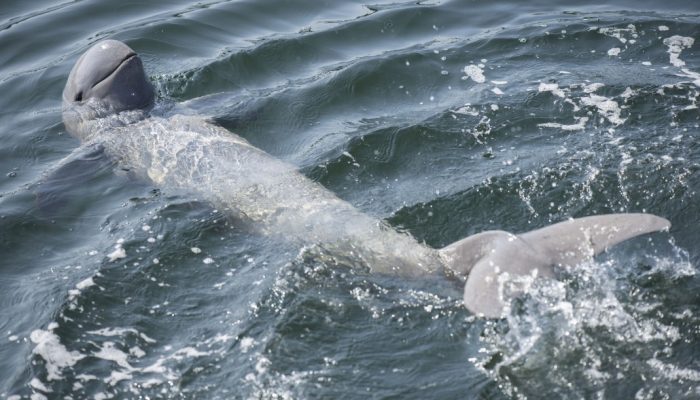
Their habitat
Their habitat varies from estuary to the bank of fresh water rivers such as the Irrawaddy in Myanmar, Mahakham in Indonesia, Bhramabutra in India and the lower Mekong. Local fishermen say that whenever flooding occurred in the past, dolphins swam upstream to the north about 900 kilometres from Mekong delta.
Traditionally, the dolphins are neither hunted nor their meat eaten. However, they come into regular contact with human beings because of their habitat—warm, shallow coastal waters.
Today, dolphins get killed when they get entangled in fish nets and from residents’ use of homemade explosives and dynamite to catch fish in the “deep pools”—the widest part of the river where water levels do not exceed eight to 10 metres during low tide, and where they seek refuge and feeding ground during the dry season.
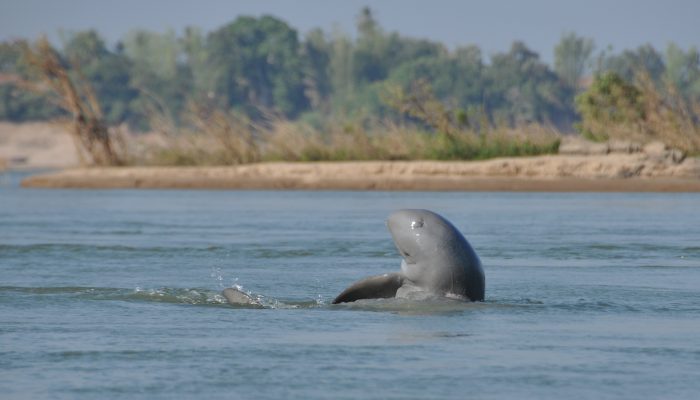
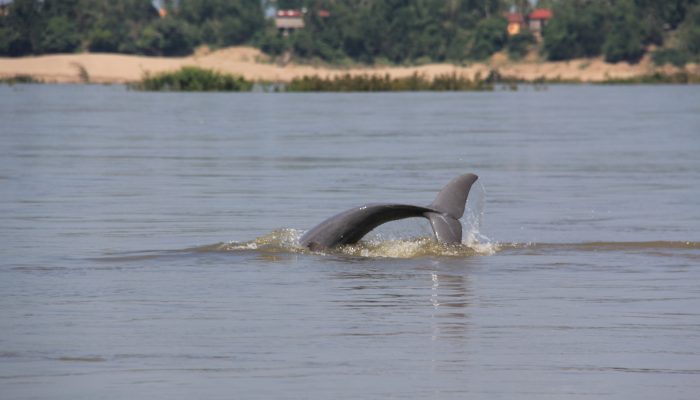
The precarious state of the Irrawaddy dolphin
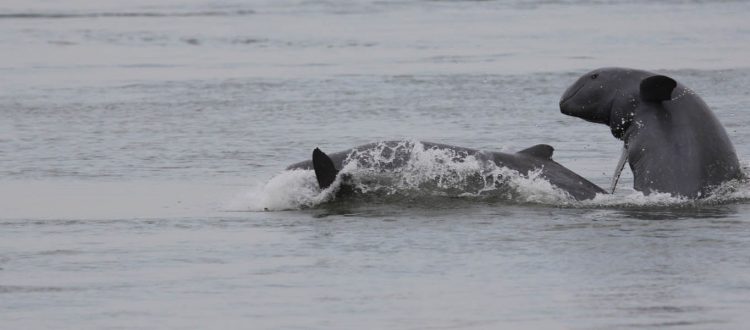
Research confirms the precarious state of the Irrawaddy dolphin, says Baird, who set up the Lao Community Fisheries and Dolphin Protection Project years back to study the Irrawaddy dolphins in the Lao part of the Mekong.
He later expanded his study to include Cambodia, after he found out that the majority of the dolphin population have migrated to Laos’ southern neighbour.
He estimates that there are 40 dolphins in the north-eastern part of Cambodia, for a total of about 100 dolphins altogether in the Mekong river.
“With these small size populations, it’s hard to ensure their existence in Mekong river,” he pointed out.
This in sharp contrast to the fifties, when there were up to thousands of the dolphins along the Mekong River, which runs from China down to Vietnam.
According to Baird’s habitat and distribution study of the dolphins in Ban Hang Khone, near the border of Laos and Cambodia, 27 dolphins were killed between December 1990 to September 1998, or a mortality rate of three dolphins a year.
Most of them, he says, got entangled in nylon fish nettings set up by local fishermen to catch other fish, and drowned. Dolphins need to emerge from the water every five to seven minutes in order to breathe.
During the flooding season, Mekong dolphins follow migratory groups of fishes from the eastern Cambodian province of Kratie to various tributaries upstream.
But during the dry season, usually December to mid-May, their sanctuary is limited. Usually they migrate to the river’s “deep pools” to ensure their own safety and to use as feeding ground during this time, and this makes them easy to spot, adds Baird.
Surveys show that there are 36 “deep pools” in the Mekong, including the ones in lower Sekong and Se San Rivers, apart from the other five tributaries along the Lao-Cambodia border, for Irawaddy dolphins to take refuge in during the dry season.
Apart from these threats to the dolphin population, Baird says that the future dam construction by the Lao government in the Mekong tributaries—contained in its development plans—would hurt the endangered species further.
If these dams are carried out, he says, Irrawaddy dolphins and many species of fishes in the Mekong River are likely to become extinct because their habitats would be devastated and altered permanently.
According to an IUCN paper, “possibly the most significant threat to river cetaceans is the construction of large water development structures, most notably dams, barrages, and levees”.
“The environmental consequences of water development projects are significant and far reaching. These structures fragment populations and reduce the environmental complexity that makes rivers suitable for aquatic species,” it added, pointing out that other Asian river dolphins are, like the Irrawaddy dolphin, under serious threat.
“The future of the Irrawaddy dolphin may well be determined by the forces of ecotourism and commercial development,” the Bangkok-based English newspaper ‘Bangkok Post’ said in a recent report.
Apart from Laos, other countries have plans to build hydroelectric dams along the Mekong or its tributaries. A navigation agreement signed last year also seeks to widen the Mekong to facilitate commercial travel.
But for now, efforts like the establishment of Fish Conservation Zones (FCZ) are underway to help save the Irawaddy dolphin and other fish species.
These aim to stop or decrease fish netting around many of these deep pools, since dolphins and many fishes use the pools during the dry season. For instance, there are more than 60 deep pools around the villages of Si Phun Don in Champasak district now, says Baird.
He points out that cooperation among local villagers, and the preservation of the ecological system of Mekong, is key to protecting the Irawaddy dolphin.
Groups like Oxfam International also started dolphin conservation in Cambodia six years ago.
A distant cousin
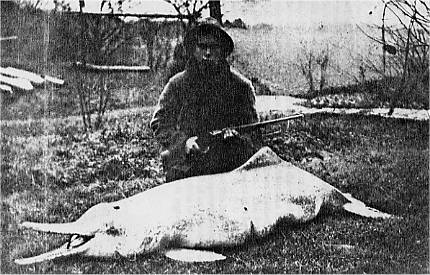
the Yangtze river dolphin driven to extinction
The Yangtze river dolphin, until recently one of the most endangered species on the planet, has been declared officially extinct following an intensive survey of its natural habitat.
The freshwater marine mammal, which could grow to eight feet long and weigh up to a quarter of a tonne, is the first large vertebrate forced to extinction by human activity in 50 years, and only the fourth time an entire evolutionary line of mammals has vanished from the face of the Earth since the year 1500.
Conservationists described the extinction as a “shocking tragedy” yesterday, caused not by active persecution but accidentally and carelessly through a combination of factors including unsustainable fishing and mass shipping.
In the 1950s, the Yangtze river and neighbouring watercourses had a population of thousands of freshwater dolphins, also known as Baiji, but their numbers have declined dramatically since China industrialised and transformed the Yangtze into a crowded artery of mass shipping, fishing and power generation. A survey in 1999 estimated the population of river dolphins was close to just 13 animals.
Historically, the species had been revered and achieved nearly demi-god status among fishermen who recounted tales of dolphins being reincarnations of drowned princesses. But in Mao’s Great Leap Forward, the overthrowing of idols saw their protection lifted and they were hunted for food and their skin.
Sam Turvey, a conservation biologist at London Zoo, worked with Chinese government scientists to survey the entire 1,669km stretch of the Yangtze river downstream of the giant Three Gorges Dam to Shanghai, a region which has been the natural habitat for river dolphins.
The team scoured the river four times in two boats during the six-week survey, using high-powered binoculars to spot the dolphins. Sensitive hydrophones were towed behind to listen for their calls.
The researchers hoped that if any dolphins were spotted, they could be taken to a reserve in an oxbow lake which was once part of the Yangtze in the hope of boosting their numbers. But at the end of the survey, they had neither seen nor heard any sign of the dolphins, according to their report in the journal Biology Letters.
“We passed through what were supposed to be Baiji hotspots and every day there was nothing. The hopes of each person on the survey died at different points; everyone had a moment of realisation that we weren’t going to find anything,” said Dr Turvey.
Around half of all river dolphins were killed as a result of indiscriminate and often illegal fishing practices. Though banned for the past 30 years, some ships still drag long lines of unbaited hooks. “They just drift through the water snagging everything. They slash and entangle and suffocate the dolphins,” said Dr Turvey. Low employment in the 1980s and 1990s saw a rise in unskilled fishing.
Dr Turvey said conservation organisations had been quick to call for action to protect the river dolphin, but many were too cautious to take meaningful action.
“The loss of such a unique and charismatic species is a shocking tragedy. The Yangtze river dolphin was a remarkable mammal that separated from all other species over 20m years ago. This extinction represents the disappearance of a complete branch of the evolutionary tree of life,” Dr Turvey added.